Going to the West Indies in 1502, he became a judge in the colonial administration of Hispaniola(Santo Domingo). In 1520 he went to Mexico to mediate the dispute between the Spanish commanders Hernán Cortés and Diego Velázquez.
An expedition sent by him under the command ofFrancisco Gordillo made a landfall near Cape Fear, N.C., in 1522, and in 1523 Ayllón was authorized by the Holy Roman emperor Charles V (King Charles I of Spain) to explore that area, especially to find a strait to the Spice Islands. In the early summer of 1526 Ayllón sailed from Hispaniola to found a settlement called San Miguel de Guadalupe, probably at the mouth of the Pee Dee River (Winyah Bay), in South Carolina. (Little credence can be given to the claim that the settlement was made at Jamestown, Va., 81 years before the English arrived there.) The colony was abandoned a few months later, after Ayllón and many others had died in a fever epidemic.Ayllón, Lucas Vásquez de
Written by
~~~~~~~~~~~~~~~~~~~~~~~~~~~~~~~` ~~~~~~~~~~~~~~~~~~~`````
ca. 1480–18 Oct. 1526
Lucas Vásquez de Ayllón, explorer, was the son of Judge Juan Ayllón, head of a noble and rich family of Toledo, Spain, which probably originated in the province of Segovia. Ayllón was educated in civil law, probably at the University of Salamanca. His fondness for adventure explains his reluctance to remain in Toledo and enjoy the position and wealth of his family. Consequently, he was sent to Santo Domingo by Cardinal Jiménez de Cisneros—founder of the University of Alcalá and adviser to Queen Isabel and King Ferdinand—as one of three justices of the supreme court. The party, including three Hieronymite monks, arrived in the island in 1516.
For several years, Ayllón had no unusual experiences in his position as judge. However, after the arrival of Cortés in Mexico, the situation changed abruptly. Both Diego Velázquez, the governor, and Rodrigo de Narváez were jealous of the newcomer and the success he seemed to have in New Spain. They decided to send a force to stop him. Some time later, Ayllón was given the difficult assignment of attempting to dissuade them from interfering with Cortés. The authorities did not relish the possibility of the natives of New Spain witnessing what would amount to civil war between two factions of the invading Christians. For his efforts, Ayllón got a very rude reception from both Velázquez and Narváez, and also a short period of imprisonment. Cortés continued to be master of the situation in Mexico.
Ayllón was intrigued by the colorful stories brought to Santo Domingo by Francisco Gordillo, who had sailed along the coast of Florida as far as latitude 33°30'. With a slave trader, Gordillo had captured some seventy Indians. Ayllón ordered the Indians released, but he could not forget the stories told of Florida; he finally decided to go to Spain with a request for permission to explore the coast of Chicora. The permission was granted, and at the same time the Emperor Charles Vmade Ayllón a Knight of the Order of Santiago, the highest Spanish military order. The historian Oviedo, who was in Spain at the same time, says that he passed by the famous Hieronymite Monastery of Nuestra Señora de Guadalupe, a mecca for returning voyagers after Columbus's visit there in 1493, where he saw Ayllón, just honored by the emperor.
Ayllón returned to Santo Domingo in June 1526 and immediately made plans to send an expedition to Florida with [Diego?] Miruelo as chief pilot. The expedition, financed by Ayllón, sailed with three ships: La Bretona, the flagship; and two smaller vessels, Santa Catalina and Chorruca; as well as a smaller boat to be used in exploring inland waters. With more than five hundred men, women, and children, black slaves, and several friars of the Order of Preachers, they sailed to latitude 33°40', to an area that had been called Chicora and to a stream called the River Jordan. The whole area was marshy, infested with mosquitoes, and obviously not suitable for the establishment of their new utopia. The expedition sailed about 150 miles to the southwest, perhaps to the Cape Fear River. The Indians of the area, aware that the newcomers had suffered a setback to the north, attacked almost immediately. And as so often happened to Spain in America, dissension arose among Ayllón's followers. Ayllón and many others became seriously ill of a fever. He died on St. Luke's day. One contemporaneous report says that his body was thrown into the sea. The rest of the party, now numbering fewer than 150, returned with the one remaining ship to Santo Domingo.
Ayllón was a pioneer in introducing sugar into the New World and with one Francisco de Ceballos built a fine sugar mill on the north coast some forty-five leagues from Santo Domingo, an enterprise that was managed by his heirs after his death. Ayllón had at least two children, including a son who in 1562 requested and received permission to establish a colony in Chicora, where his father had failed and died, but who himself died before he could put his plan into operation. Ayllón's daughter, Doña Inés de Villalobos, married Juan de Junco, a captain who had sailed with Sebastian Cabot. Ayllón had at least one brother, Perálvarez, also a member of the Order of Santiago, who fought with Caesar Borgia in Italy and who was both a poet and a dramatist.
After Ayllón's failure to etablish a colony in Chicora, the emperor never again turned his eyes to the northern latitudes of North America, leaving that area to the English and the French.
Ayllón was a most unusual man to be interested in establishing a colony in the wilderness. Rich, noble, well educated, he offered a strong contrast to most of the conquistadores. He used his own resources to finance the expedition, asking the emperor only for permission. In some measure he resembles Sir Walter Raleigh. There is one big difference: Walter Raleigh never came close to the shores of North Carolina.
by Sterling Stoudemire, 1979
This article is from the Dictionary of North Carolina Biography, 6 volumes, edited by William S. Powell. Copyright ©1979-1996 by the University of North Carolina Press. Used by permission of the publisher. For personal use and not for further distribution. Please submit permission requests for other use directly to the publisher.
by Sterling Stoudemire, 1979
This article is from the Dictionary of North Carolina Biography, 6 volumes, edited by William S. Powell. Copyright ©1979-1996 by the University of North Carolina Press. Used by permission of the publisher. For personal use and not for further distribution. Please submit permission requests for other use directly to the publisher.
References:
Edward G. Bourne, Spain in America: 1450–1580 (1904).
Hernán Cortés, Cartas de relación al Emperador Carlos V (1866).
Bernal Díaz del Castillo, Historia verdadera de la conquista de México, ed. Joaquín Ramírez Cabañas (1939).
Encyclopedia universal illustrada, Espasa-Calpe, vol. 67.
Gonzalo Fernández de Oviedo, Historia general y natural de las Indias, ed. Pérez de Tudela, 5 vols. (1959).
Henry Harrisse, The Discovery of North America, facsimile ed. (1931).
Antonio de Herrera y Tordesillas, Décadas, ed. A. Ballesteros (1934).
Hugh T. Lefler, "Explorations and Attempts at Settlement," in Blackwell P. Robinson, ed., The North Carolina Guide (1955).
Hugh T. Lefler and Albert R. Newsome, North Carolina: The History of a Southern State (1954).
Salvador de Madariaga, Hernán Cortés, Conquest of Mexico (1958).
Mapa Oficial Española, 1527, and Map of Diego Rivero, 1529, in Johann George Kohl, ed., Die Beiden Altesten General-Karten von Amerika Ausgfuhrt in Jahren 1527. un 1529 auf befehl Kaiser Karls V. (1860).
Samuel Eliot Morison, The European Discovery of America: The Northern Voyages, 500–1600 (1971).
John Gilmary Shea, Narratives and Critical History of America, ed. Justin Winsor (n.d.).
Garcilaso de la Vega, La Florida del Inca (1956).
Additional Resources:
Biography in the New Advent: http://www.newadvent.org/cathen/02164c.htm
Enchanted Learning: http://www.enchantedlearning.com/explorers/page/d/deayllon.shtml
Shackleford Horses: http://shacklefordhorses.org/timeline.htm
North Carolina Genealogical Society journal, North Carolina Digital Collections:http://digital.ncdcr.gov/cdm/compoundobject/collection/p15012coll1/id/61459/rec/2
Maritime history and survey of the Cape Fear and Northeast Cape Fear rivers, Wilmington Harbor, North Carolina. Volume 1: Maritime history, North Carolina Digital Collections:http://digital.ncdcr.gov/cdm/compoundobject/collection/p249901coll22/id/398198/rec/1
Subjects:
Authors:
From:
~~~~~~~~~~~~~~~~~~~~~~~~~~` ~~~~~~~~~~~~~~~~~~~~~~~~~``
Lucas Vasques de Ayllon (1475-1526)
Portuguese cartographer Diego Ribero updated the official world map to reflect new discoveries. In his 1529 map, the southeastern U.S. was labeled "Tierra de Ayllon." This image appeared in Johann Georg Kohl's printing of the map, ca. 1850.
A lawyer and nobleman from Spain, Lucas Vasques de Ayllon sponsored the first Spanish explorations (three total) of what became North Carolina. He also discovered Chesapeake Bay and established San Miguel de Guandape, a settlement near what would be Jamestown.
Ayllon sponsored three missions to the New World. In 1521, he sent Francisco Gordillo to find a Northwest Passage. The Spaniard landed near the Cape Fear River and explored a land called Chicora (between the Cape Fear and Jamestown Island). In 1524, Ayllon traveled to Chicora for his second mission, discovered the Chesapeake Bay, and offered a report to Charles V, who made the nobleman the lifetime governor of the land that he had explored. His last mission was in 1525 to 1526.
Ayllon sponsored three missions to the New World. In 1521, he sent Francisco Gordillo to find a Northwest Passage. The Spaniard landed near the Cape Fear River and explored a land called Chicora (between the Cape Fear and Jamestown Island). In 1524, Ayllon traveled to Chicora for his second mission, discovered the Chesapeake Bay, and offered a report to Charles V, who made the nobleman the lifetime governor of the land that he had explored. His last mission was in 1525 to 1526.
Ayllon and approximately 500 to 600 colonists (including three monks) sailed to the New World in a convoy of 6 ships. They landed near the Cape Fear River (which they called Rio Jordan), but decided to go to a more salubrious place. They went north and established San Miguel de Guandape. Disease, however, plagued the Spanish settlement, and the numbers dropped quickly to 150. The dead included Ayllon.
Shortly afterward, Spaniards abandoned San Miguel de Guandape and approximately eighty to one hundred horses. Many wild horses on Shackleford Banks near Beaufort, North Carolina are believed to be descendants of those that the Spanish deserted.
Sources:
Edward P. Spillane, “Lucas Vasques de Ayllon” in Catholic Encyclopedia Vol. II (New York, 1907), also found at http://www.newadvent.org/cathen/02164c.htm (accessed August 7, 2007; Wild Horses of Shackleford Banks, “History on Hooves: The Horses of Shackleford Banks”http://www.shacklefordhorses.org/timeline.htm (accessed August 7, 2007); William S. Powell, North Carolina: Through Four Centuries (Chapel Hill, 1989).
By Troy L. Kickler, founding director of the North Carolina History Project
See Also:
Timeline: Pre-1585Region: Coastal Plain
~~~~~~~~~~~~~ ~~~~~~~~~~~~~~~~
The Spanish in Virginia Before Jamestown
http://www.virginiaplaces.org/settleland/spanish.html
The English were not the first Europeans to try to colonize the Chesapeake Bay. The Spanish discovered what they called the "the Bahia de Santa Maria," explored the eastern coast of North America extensively, and tried to establish settlements in several locations in order to:
- 1) find a sea passage to China and the Spice Islands
- (Columbus had also sought faster passage for more-profitable trade in his 1492 voyage.)
- 2) block French expansion from Canada and South Carolina south towards the Spanish settlements in Florida
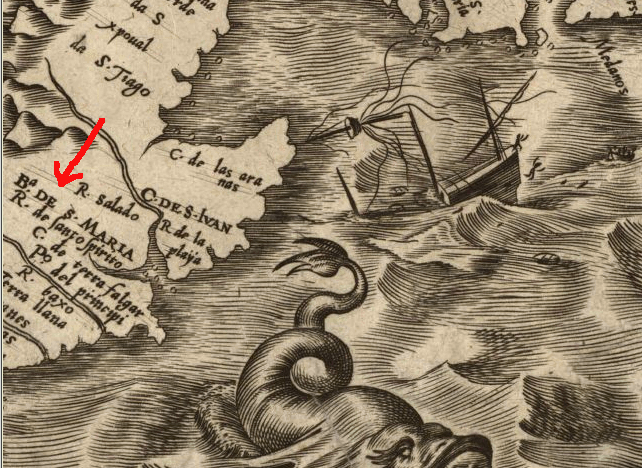 (The oldest continually-settled city in North America is St. Augustine in Florida, founded a year before Pedro de Menendez de Aviles sailed into the Bahia de Santa Maria.)
(The oldest continually-settled city in North America is St. Augustine in Florida, founded a year before Pedro de Menendez de Aviles sailed into the Bahia de Santa Maria.)- 3) block English privateers or pirates from creating a base of operations in the Chesapeake Bay to raid Spanish gold/silver shipments sailing from the Caribbean
- (Privateers had authorization from a government, so they were essentially mercenaries working on commission. Pirates had no "political cover" but could keep all the loot The distinction was rarely 100% clear in practice...)
- 4) convert the Natives to Christianity
- (Faith was an arm of government, monarchs served by "divine right," and control of religious belief was considered necessary to control political and economic behavior.)
- 5) discover unknown riches that may exist in unknown territories
- (The wealth of Mexico and Peru was a surprise - perhaps the interior of North America would surpass it.)
the Spanish sought to block rivals from areas north of St. Augustine, Florida Map Source: US Geological Survey, National Atlas | 1562 map showing Chesapeake Bay as Bahia de Santa Maria (can you identify the possible locations of the James and the Susquehanna - or Potomac - rivers?) Source: Library of Congress, 1562 map by Diego Gutiérrez - Americae sive qvartae orbis partis nova et exactissima descriptio |
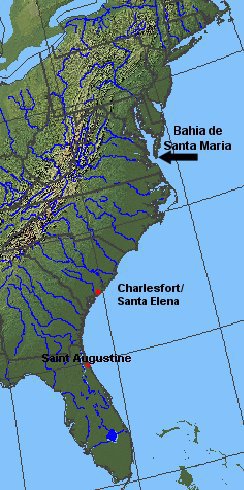 One of their first attempts at settlement on the east coast of North America was in 1526, when Lucas Vazquez de Ayllón founded the colony of San Miguel de Gualdape. It could have been at Charlesfort/Santa Elena (near modern-day Parris Island) in South Carolina, or in Georgia around the 33 degree of latitude1, but some2 have confused this 1526 effort with the 1570 attempt by the Spanish to start a settlement in the Chesapeake Bay.
One of their first attempts at settlement on the east coast of North America was in 1526, when Lucas Vazquez de Ayllón founded the colony of San Miguel de Gualdape. It could have been at Charlesfort/Santa Elena (near modern-day Parris Island) in South Carolina, or in Georgia around the 33 degree of latitude1, but some2 have confused this 1526 effort with the 1570 attempt by the Spanish to start a settlement in the Chesapeake Bay.
Half a century after discovering the New World, the Spanish had established successful colonies in Central and South America and were actively pillaging the native tribes of their gold and silver. The primary threat to the fleet carrying New World wealth back to Spain came from the French, English, and Dutch. By the mid-1500's, those nations were busy trying to capture ships that were bringing booty back to Spain from Central America, and at risk of establishing bases in North America to support the intercept-the-Spanish-fleet efforts.
- The other major colonial power at the time was Portugal. Under the Treaty of Tordesillas in 1494, Portugal claimed Brazil and Spain claimed the rest of the New World. As a result, Portugal focused on Africa and Brazil, plus control of the slave trade, and never sought to plunder/settle North America.
The Spanish did not have a large enough population to plant settlements up the North American coast, in addition to settling Mexico and later New Mexico (including much of the land now included in the United States, from Texas to California). Between 1539 to 1543, Hernando de Soto and his successor explored north from the Gulf of Mexico, but did not attempt to establish any long-term settlements - and turned west before he reached the modern-day boundaries of Virginia.

possible paths of Hernando de Soto expedition through the Southeast, 1539-40
Source: National Park Service Cultural Overview, Ninety Six National Historic Site
| The Spanish did recognize the need to control the North American coastline on the Atlantic Ocean, to protect their shipping and to block Euopean rivals from getting established before the Spanish could "grow north." In a conscious plan, they decided to use their base at Havana to establish new Spanish towns in Florida, and to eliminate rivals north of the new settlements. The short-lived Spanish settlement in Virginia, established by Father Juan Baptista de Seguera in the Bahia de Santa Maria (Chesapeake Bay) watershed, was part of the Spanish defense network. Spanish activity in Virginia was spurred by the international rivalry between separate nations on the other side of the Atlantic Ocean. In 1561, Pedro de Menendez de Aviles sailed into the Bahia de Santa Maria. He convinced (or seized) the son of a chief to travel to Spain.3 The captured Virginia natives were Paquiquino, the 17-year old son of the werowance at "Ajacan," and a companion from the Kiskiack/Chiskiak town on the York River. They were the the first Virginians to visit the Old World.
The small band of missionaries expected to rely upon Paquiquino/Don Luis to negotiate with the Virginia natives to obtain food; in all the time with Paquiquino/Don Luis, no missionary learned the local language of the Algonquians. The missionaries also presumed they could convert the Native Americans.
The Spanish sailed up the James, the largest tributary to the Chesapeake Bay at Hampton Roads - that's a logical decision. However, unlike the English who 37 years later would stayed where they disembarked at Jamestown, the Spanish settlers walked all the way across the Peninsula. The missionaries carried everything they owned, by hand, from what the English would later call the James River all the way to the York River.
What was the attraction on the York River? The shorelines offered the same hunting and gathering habitats, and the drinking water from the York River was just as salty. Perhaps Paquiquino/Don Luis was looking for his home village, but another possibility is that the foreign missionaries wanted to locate themselves as close as possible to the spiritual center of the Native Americans.
For as much as 200-300 years before the Spaniards arrived, a site on the north bank of the York River had been "special," and would later become Powhatan's capital of Werowocomoco. If the Spanish missionaries intended to confront the pre-existing "pagan" beliefs of the Algonquians living in Tidewater Virginia, then locating the new settlement near the existing spiritual center made sense - but was also a greater threat to the existing culture, putting the missionaries lives at risk.
Paquiquino and his fellow captive were exposed to Spanish-style living, and partially acculturated before being exhibited to the Spanish royal family and society "at court" in Spain. This allowed Menendez to impress people (including potential financial backers and political supporters) at home, and to expose the Native Americans to the grandeur of European culture. Exhibiting the exotic Native Americans also showed other Europeans that Spain continued its leadership position in exploring and discovering riches in the New World, roughly 40 years before the English sailed to Jamestown. Exploration in the colonial era was a two-way discovery process between two societies. Some Virginia natives explored Europe (thanks to the Spanish) before the English explored Virginia.villages of Werowocomoco and Kiskiack (at modern-day Yorktown Naval Weapons Station) about 50 years after Paquiquino met the Spanish, with possible route of Spanish from landing site (x) to Kiskiack
Source: Library of Congress, Virginia / discovered and discribed by aptayn John Smith, 1606
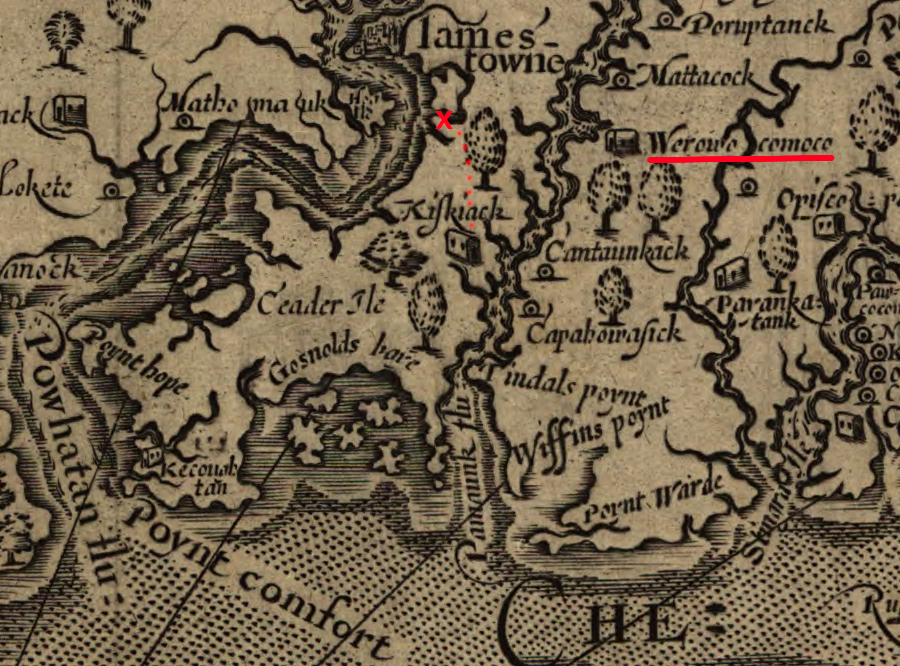 Paquiquino was taught the Spanish language and the Catholic religion by Dominican friars initially, then later by Jesuits in Mexico. Paquiquino was also quizzed at length about the mineral resources in his area and any rivers that could have offered a path to the Pacific. |
| The "freshman year of college" in Spain lasted from September, 1561 to May, 1562. Menendez then took Paquiquino to Mexico for more training. In 1566, Menendez arranged for Paquiquino, by now known by the name of "Don Luis," to go back to the Bahia de Santa Maria/Chesapeake Bay. Apparently the Spanish ship could not find the entrance to the bay, however, so Paquiquino/Don Luis was carried to Spain again. In 1570, he was finally brought back to Virginia in a party of Jesuit missionaries led by Father Juan Baptista de Seguera. The Spanish were trying to build a Jesuit mission that would block rival Europeans from occupying the area:4 The whole Atlantic coastline, from the peninsula in the south to the island of Newfoundland in the north, was known as La Florida. Since discovery of the area in 1513 by Juan Ponce de Leon, no fewer than five attempts had been made by the Spanish to establish a colony in various parts of La Florida. The sixth, successful attempt, at San Augustin [St. Augustine, Florida] in 1565, came in response to two French efforts to set up a colony at Santa Elena (or Charlesfort) on present-day Parris Island, South Carolina...
|
in 1570, Spanish missionaries crossed the Peninsula from their initial landing site, to locate their Ajacan settlement at the Native American village of Kiskiack - close to the Algonquian spiritual center, at the site Powhatan called Werowocomoco Map Source: US Fish and Wildlife Service, Wetlands Mapper |
Paquiquino/Don Luis had been thoroughly exposed to Spanish culture in Mexico, Spain, and Havana before being returned home to the Bahia de Santa Maria with eight priests and a novice who was training to join the Jesuits. But how much was Ajacan "home" to him? Think an Algonquian who had spent much of his adolescence and all of his adult life in Spanish culture had a clear understanding of where was his home?
Despite all those years in Spain and Mexico, Paquiquino had sought to return to Ajacan. He convinced the Spanish to carry him back to the Bahia de Santa Maria twice.
- Paquiquino may have called it the Chesapeake or "great shellfish bay," if he retained his pre-capture terminology. Queen Elizabeth had become ruler of England in 1558, but no one called anything in the New World "Virginia." In 1570, neither the Spanish nor the Algonquians would have used references to English leaders (King James and his son, the Duke of York), when referring to the rivers...
The Spanish gambled that Don Luis/Paquiquino would follow the Spanish way of life after being reintroduced to his village of Ajacan. Instead, Paquiquino quickly demonstrated that his personal choice was to return to his tribal lifestyle. He moved to another town, and took several wives in accordance with his status in Virginia society and in clear contrast to his Catholic teachings. Obviously 9 years in Spain and Mexico had not erased his first 17 years of Algonquian acculturation.
Paquiquino and his tribe were unwilling to support the Spanish missionaries. 1570 was a time of drought, and the Native Americans refused to provide free food or supplies to the missionaries. By December, 1570, the Spanish had traded away their tools for food. In February, 1571, after Father Seguera appealed to "Don Luis" for aid, Paquiquino eliminated the Spanish settlement. He followed Father Seguera back from the appeal for food and (with others from the town) killed him and all the other missionaries except for a young boy, Alonso de los Olmos.
This was not the end to the Spanish exploration and settlement efforts, however. In 1566 and 1568, Juan Pardo explored into western North Carolina and Tennessee, perhaps reaching Saltville in western Virginia. In 2013, archeologists discovered the exact location of Pardo's Fort San Juan, built in 1567 at a site that is now 75 miles northwest of Charlotte, North Carolina.6
The small band of missionaries expected to rely upon Paquiquino/Don Luis to negotiate with the Virginia natives to obtain food; in all the time with Paquiquino/Don Luis, no missionary learned the local language of the Algonquians. The missionaries also presumed they could convert the Native Americans.
The Spanish sailed up the James, the largest tributary to the Chesapeake Bay at Hampton Roads - that's a logical decision. However, unlike the English who 37 years later would stayed where they disembarked at Jamestown, the Spanish settlers walked all the way across the Peninsula. The missionaries carried everything they owned, by hand, from what the English would later call the James River all the way to the York River.
What was the attraction on the York River? The shorelines offered the same hunting and gathering habitats, and the drinking water from the York River was just as salty. Perhaps Paquiquino/Don Luis was looking for his home village, but another possibility is that the foreign missionaries wanted to locate themselves as close as possible to the spiritual center of the Native Americans.
For as much as 200-300 years before the Spaniards arrived, a site on the north bank of the York River had been "special," and would later become Powhatan's capital of Werowocomoco. If the Spanish missionaries intended to confront the pre-existing "pagan" beliefs of the Algonquians living in Tidewater Virginia, then locating the new settlement near the existing spiritual center made sense - but was also a greater threat to the existing culture, putting the missionaries lives at risk.
In 1571, a Spanish ship back in the Bahia de Santa Maria (Chesapeake Bay) discovered the situation at Kiskiack. In 1572 another ship returned to "rescue" the boy and punish Paquiquino and his people. In the end, nearly 40 natives were killed, including 7 hung from the ship's rigging in full view of the people on the shoreline. The boy was returned to Spain, and future attempts at settlement in Mexico were designed to be self-sufficient in food and translators.
In 1580, over 25 years before Jamestown was settled, Father Juan Baptista de Seguera was long dead - but there were 400 people living at Santa Elena. Spanish fortifications on the coastline north of Saint Augustine were abandoned in 1587, after Sir Francis Drake attacked and captured Saint Augustine in 1586 (before stopping at Roanoke Island and bringing English settlers at that colony back to England). The Spanish then concentrated their military resources in Florida to protect the sea traffic through the Caribbean.... leaving South Carolina and Georgia open to future English colonies.
The Spanish did not attempt to settle Virginia again. Instead, they tracked English activities in North America through spies in England, and perhaps at Jamestown itself.
The Treaty of London in 1604 opened the way for English colonies in the New World, at least as the English interpreted it. The treaty was not crystal clear, and instructions to the Jamestown colonists made clear that an attack by the Spanish on the new colony was to be expected.
As a result of the Spanish visits to the Chesapeake Bay in the 1500's, the Native Virginians gained a warped - or perhaps clear - understanding of European behavior. Seeing their captured men hung from the ship's masts in 1572 must have left a lingering image that affected the greeting given the English visitors in sailing ships in 1607.
One especially-intriguing possibility is that the Native Americans in Tidewater Virginia learned about European culture and empires from Paquiquino/Don Luis. The English who settled at Jamestown discovered an unusual confederation of the tribes under Powhatan. The political sophistication of the Powhatan Confederacy may reflect the unique understanding of another culture, provided by one Virginian who had been trained by the Spanish in the European liffestyle.
NOTE: Saint Augustine, Florida, settled in 1565, rightly claims to be the oldest continuously occupied European settlement in North America. The English started 20 years later, but failed in their first efforts to settle the New World at Roanoke Island in 1585 and 1587. The English failed again at Popham Colony at the mouth of the Kennebec River in Maine in 1607-08, but Jamestown hung on. The English colonists briefly abandoned Jamestown in 1610, loading everyone onto ships and sailing down the James River towards the Chesapeake Bay before running into the supply expedition led by Lord De La Warr. Jamestown is famous now as the oldest successful English settlement in North America... but it's a latecomer, compared to Spanish settlements, and it's just an historic site rather than a settled town.

1584 map speculating on how Chesapeake Bay may reach inland
Source: Library of Congress, Peruuiae avriferæ regionis typus / Didaco Mendezio auctore. La Florida / auctore Hieron. Chiaues. Guastecan reg. (1584)
Links
- Archeology
- Mariners Museum
- National Park Service
- Fort Caroline National Memorial (the French colony destroyed by the Spanish in 1565)
- Spain in the New World to 1600
- Santa Elena Project
- Spanish Conquistadors in North America
- The Spanish Jesuit Mission in Virginia, 1570-1572
- Virtual Jamestown
References
1. Hackett, Charles W., "The Delimitation of Political Jurisdictions in Spanish North America to 1535," The Hispanic American Historical Review, Vol. 1, No. 1. (Feb., 1918), p.49;
2. For example, see the Lucas Vásquez de Ayllón reference in the Catholic Encyclopedia (last checked September 30, 2012)
3. Sturtevant, William C., Spanish-Indian Relations in Southeastern North America, Duke University Press, 1962, p.55
4. Charlotte M. Gradie, "Spanish Jesuits in Virginia: The Mission That Failed," The Virginia Magazine of History and Biography, Vol. 96, No. 2 (April 1988), p.133, p.135, http://www.jstor.org/stable/4249006 (last checked September 30, 2012)
5. Clifford M. Lewis, Albert J. Loomie, The Spanish Jesuit Mission in Virginia, 1570-1572, Virginia Historical Society, 1953, p.viii, http://catalog.hathitrust.org/Record/001263567 (last checked September 30, 2012)
6. "Spanish fort discovered in Morganton," Charlotte Observer, July 24, 2013, http://www.charlotteobserver.com/2013/07/23/4184813/spanish-fort-unexpectedly-discovered.html; Jim Glanville, "16th Century Spanish Invasions of Southwest Virginia," Historical Society of Western Virginia Journal, XVII(l): 34-42 (2009), http://www.holstonia.net/files/Conquistadors2.pdf (last checked August 9, 2013)
~~~~~~~~~~~~~~~~ ~~~~~~~~~~~~~~~~`



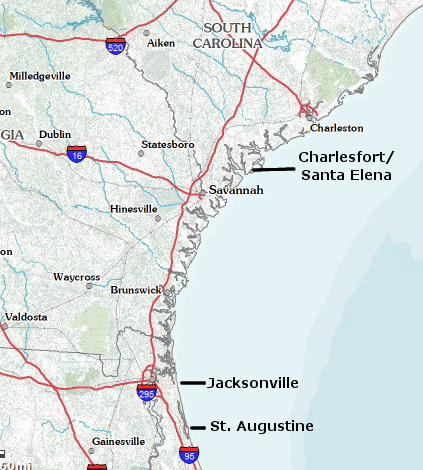
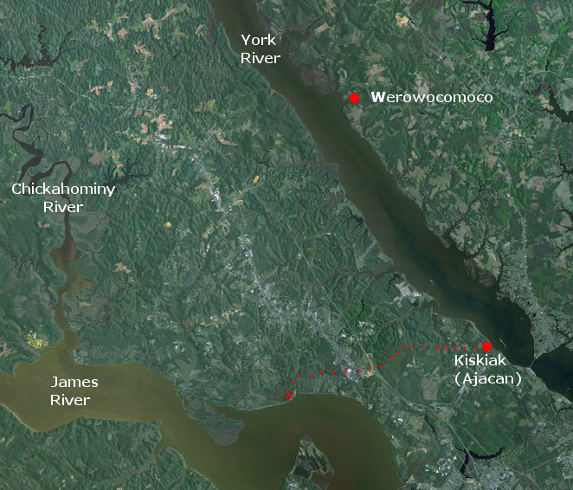
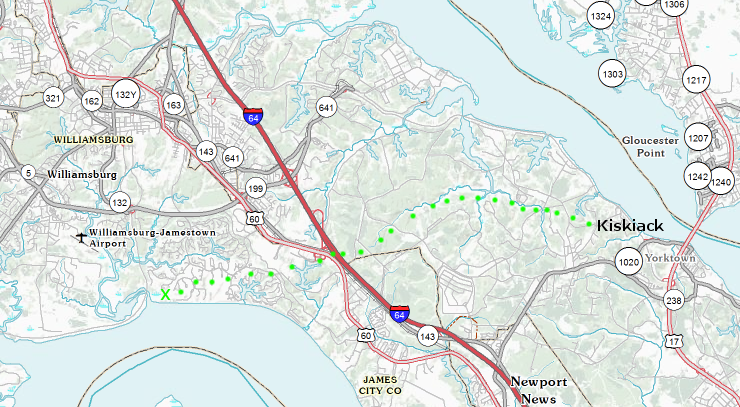
No comments:
Post a Comment